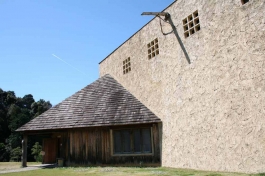Akino Fuku Museum
[Route]

| Zip | 431-3314 |
|---|---|
| Address | 130 Futamata, Futamata-cho, Tenryu-ku, Hamamatsu-shi |
| Tel | 053-922-0315 |
| Fax | 053-922-0316 |
| URL | http://www.city.hamamatsu.shizuoka.jp/lifeindex/enjoy/culture_art/akinofuku/index.htm |
| Hours | 9:30am-5:00pm |
| Admission | Permanent Exhibit/ Adults:500yen High School Students: 350yen Free for over 69 and Physically Challenged People |
| Close | Mondays (except holidays) Days after Holidays New Year's Holidays Exhibition Replacement Period Fumigation Period |
Establishment
Akino Fuku Museum (Akino Fuku Bijyutukan) was established in April 1998. It aims to introduce the works of Akino Fuku and to provide a place for citizen to work on their creative activities. Fujimori Terunobu designed the building. It is unique on the aspect that it was built with plenty of natural materials such as plasters on its walls. It uses timbers from Tenryu region. The museum stands on a hill surrounded by trees above Futamata-cho.
Contents
The building is two-storey. Permanent Exhibition is held on the first floor. Special exhibitions, galleries of citizen’s works, and lectures are held on the second floor. Akino was born in Futamata-cho, Tenryu-ku in 1908. She learned painting under Ishii Rinkyo and Nishiyama Suishō. At age 28, she won a prize at Kan-Ten (government-sponsored exhibitions). Later on, she took off from the style of Kan-Ten, and introduced western painting methods into her paintings. She was invited to teach at a university in India when she was 54. She fell in love with the country and created pieces inspired by its scenes and temples. In 1999, she was awarded with Order of Culture (a Japanese order which is awarded to people contributed to Japan's art, literature, and culture). The museum displays many of her works including her paintings from her Kan-Ten period and India period. It also holds special exhibitions several times a year.
Remarks
The most unique part of this museum is that you take off your shoes while you observe the paintings. Permanent Exhibition Room 1 is floored with fujigoza, Japanese mats, and Room 2 has a marble floor. Thus, visitors can sit on floor and observe the paintings at leisure. The designer decided that removing one's shoes would better suit the nature of the paintings.